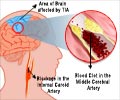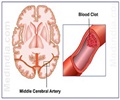When a stroke strikes, the supply of blood to the part of the brain affected is interrupted, starving it of oxygen.
When a stroke strikes, the supply of blood to the part of the brain affected is interrupted, starving it of oxygen. Brain cells can be seriously damaged or die, impairing local brain function.
But the brain is a battler. Within weeks of a stroke, new blood vessels begin to form, and, like marching ants, newly born neurons migrate long distances to the damaged area to aid the regeneration process. What’s not known is what the right cellular environment is, and what the cellular cues are for this process of regeneration and migration to take place.Now, in the Journal of Neuroscience, currently online, S. Thomas Carmichael, M.D., Ph.D., an assistant professor in the Department of Neurology at the UCLA Geffen School of Medicine, and colleagues report that in the mouse model, this neuron march is the direct result of signaling from the newly blooming blood vessels, thus casually linking angiogenesis the development of new blood vessels and neurogenesis, the birth of new neurons. Further, they have identified what these molecular signals are. The results hold promise for eventual clinical applications that may spur brain repair after stroke.
Stroke is the leading cause of adult disability, said Carmichael. And while much is known about the mechanisms of cell death in stroke, little is known about the mechanisms of neurological recovery after a stroke. His lab studies the mechanisms of brain repair and the recovery of function after a stroke.
Recent research has revealed that in the adult brain, new neurons form in a region of the forebrain known as the subventricular zone (SVZ). In mice, after a stroke was initiated in a part of the brain located far from the SVZ, the researchers, using a combination of mitotic, genetic, and viral labeling, tracked newly formed neuroblasts (immature brain cells from which mature adult neurons form) as they traveled through healthy brain tissue to the stroke area. Once there, these immature neurons wrapped themselves around the immature vascular cells that were in the process of forming new blood vessels in the damaged area. The neurons were found to arrive at the site within the first two to four weeks after the stroke.
Further, the researchers found that two proteins, stromal-derived factor 1 (SDF1) and angiopoietin 1 (Ang1), that are given off by these newly-forming blood vessels, are what trigger the thousands of immature neurons to the site of damage.
"The SDF1 and Ang1 proteins are what link the two processes of neurogenesis and angiogenesis together by promoting post-stroke neuroblast migration," said Carmichael. They also appear to effect behavioral recovery as well, he noted. The researchers produced the stroke in an area of the brain that controls the mouse’s facial whiskers. When the mouse was infused by the researchers with Ang1 and SDF1, improvement in the function of the whisker’s was seen to the same levels as the control (non-stroke) mice.
Advertisement
Source-Newswise
SRM











